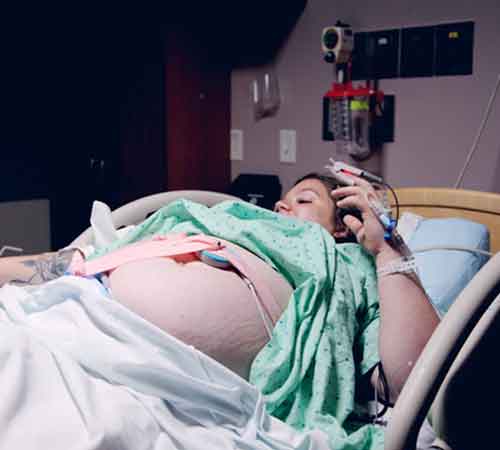
Having a cesarean delivery, commonly referred to as a C-section, can have a huge impact on a mother’s mental and physical health in the weeks after this major surgery.
For starters, you’ll need more time to recover than you would after a vaginal delivery.
To speed up this process, here are several mums vetted recovery tips to try after a C-section, so you can spend less time sore and tired, and more time bonding with your new baby.
1. The First 48-hours:
Staying in the hospital 2 to 4 days is the expected norm for women who put to bed through a C-section.
The first 48 hours after a cesarean is accompanied by many of the same post-delivery challenges (body changes, pains, and discomfort) as a vaginal delivery, with only a few additional challenges for C-section deliveries. Changes including:
2. Blood Clots
This is as a result of having your leg not in motion for several hours. In fact, one of the biggest risks of C-section is developing a blood clot in the leg.
This is more likely in people who are overweight or who remain immobile for long periods of time, due to a prolonged section.
The recovery tip for this after C-section wahala, is to get moving as soon as you’re able to, to get the blood flow return to normal again.
3. Cramps
In the first 48 hours, it is common to feel pain around the site of the incision, as well as post-birth cramps as the uterus shrinks. These sensations feel similar to menstrual cramps, but a little more intense.
4. Vaginal Bleeding
Even after a C-section, the uterus has to shed what is left of the pregnancy. This will happen in the form of vaginal bleeding. The bleeding is usually heaviest during the first few days and lasts 4 to 6 weeks after birth. And the risk of infection is highest during this period. Also, dangerous bleeding, which is known as a hemorrhage, is more likely during this time.
People should avoid returning to their normal exercise levels for 6 to 8 weeks. Driving is usually not safe for 4 to 6 weeks also.
5. The C-section Scar Site
Your wound will take approximately six weeks to heal up, then you will be left with a scar that will fade over time. You may lose feeling in the area of your wound which may come back over time.
The wound may feel sore for a week or two; this is perfectly normal. The muscle surrounding the wound may also feel weak for about 2 weeks.
When your C-section scar site has healed up to a reasonable extent, you can from time to time massage the area to break up the scar tissue/stop itching.
Lie on your back, with the use of a non-perfumed cream or lotion, make 20-30 small circular motions with your fingertips or have your spouse or another trusted person help you do this, once or twice daily.
Quick Recovery Tips After A C-Section
1. Get enough rest
As with any other surgery, your body needs time to heal afterward. You will be required to stay in the hospital for three to four days after your delivery (longer if there are complications), and give your body at least six weeks to heal reasonably.
It’s easier said than done, when you have a baby who is demanding lots of attention, I know, which is why you have to get intentional about it. Rest whenever your baby rests, take naps alongside your baby.
Have friends and relatives help out with diaper changes and house chores so you can have time for the needed rest. A few minutes of rest here and there throughout the day can go a long way in speeding up your recovery.
2. Take Walks.
Avoid strenuous exercise, but do take little walks as often as you can. All processes in the body are sped up by exercise. The movement will help your body heal and prevent constipation and blood clots. Needless to say, walks are a great way to introduce your baby to the world.
You can start by taking short walks and build up to 30 minutes after you’ve been home for a few days. Walking will increase blood circulation, which will reduce your risk for clots, aid bowel function, and increase your body’s ability to recuperate.
3. Prioritise healthy nutrition
Healthy nutrition is just as important in the months after you deliver as it was while you were pregnant, and in fact, at every phase in your life.
Consuming a healthy, well-rounded diet will help you recover faster, and also keep your baby healthy, especially if you’re breastfeeding, and are your baby’s primary source of nutrition. In addition, drink plenty of fluids, water especially. You need extra fluids to boost your breast milk supply and also to avoid constipation.
4. Don’t be a stranger to pain relief pills
Ask your doctor what pain medicines are safe to take, especially if you’re breastfeeding.
Related: 10 Intimacy Tips For Brides-To-Be
Depending on your level of unease, he/she doctor might prescribe a pain reliever or advise you to take over-the-counter pain medication such as ibuprofen (Advil, Motrin) or acetaminophen (Tylenol).
In addition to pain medicine, you can use a heating pad to relieve discomfort in the incision area.
5. When to involve a doctor
You’ll probably feel some soreness in the incision, laughing, coughing, sneezing, in the first few days will hurt, and you may have bleeding or vaginal discharge for up to six weeks after the C-section. All this is perfectly normal.
However, you know when to reach out to your doctor when there are signals pointing to an infection. Post-C-section signals as:
- Redness, swelling, or pus oozing from the incision site
- Your pain relief is not keeping your pain under control, or your pain is getting worse
- High fever
- Heavy vaginal bleeding that remains so after a week or gets heavier
- You are worried about the smell or colour of your vaginal blood
- You have a cough, chest pain or you’re short of breath
- A headache coupled with either vision problems or sickness (nausea or vomiting)
- You have pain, redness, or swelling in the calf muscle of one leg
Get more resources on motherhood here.



